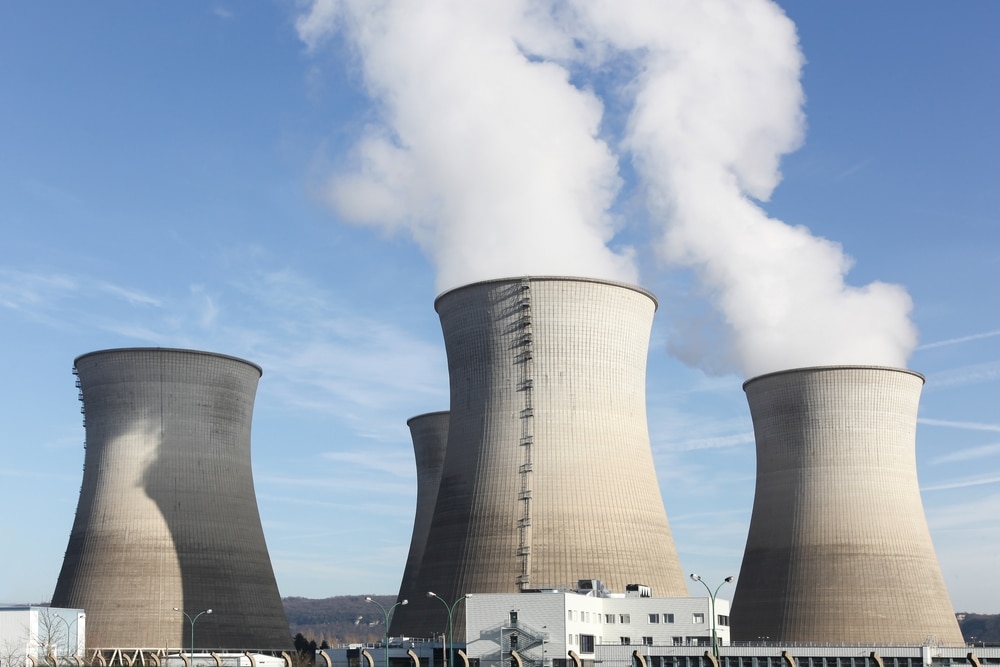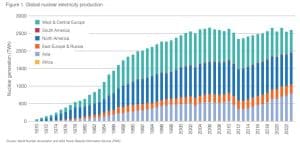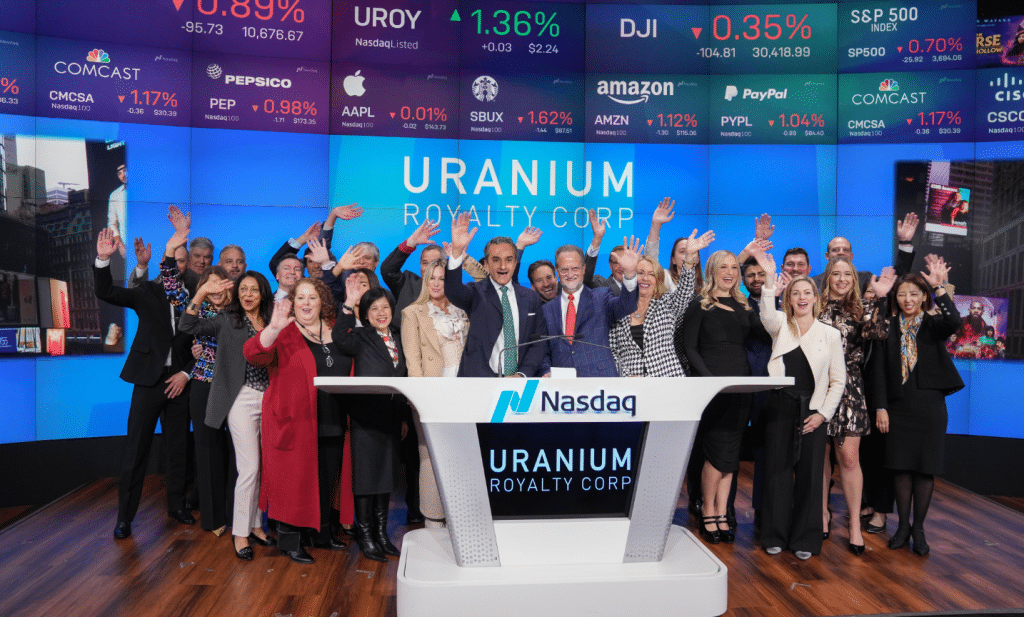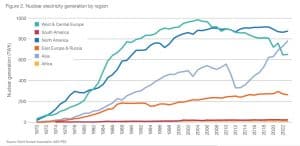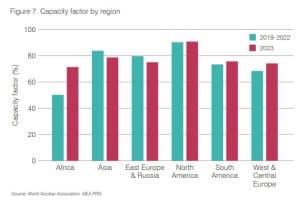A new report, The World Nuclear Performance Report 2024, reveals a significant increase in global nuclear power generation and average capacity factors. These findings demonstrate the continued excellent performance of the global nuclear reactor fleet.
Key takeaways from the report include a rise in global nuclear electricity generation to 2602 TWh in 2023, up from 2544 TWh in 2022, which now accounts for 9% of the world’s electricity. This makes nuclear power the second-largest clean energy source, following hydropower.
Moreover, the average capacity factor of nuclear reactors increased by 1%, reaching 81.5% in 2023. This sustained the trend of high global capacity factors reported since 2000, underscoring the reliability of nuclear energy as a clean energy source.
For over 20 years, nuclear reactors have consistently maintained capacity factors above 80%, highlighting their dependability in supplying energy to the grid. This long-standing performance record reinforces nuclear power’s role as one of the most reliable sources of clean energy enabled by its main fuel uranium.
A MESSAGE FROM URANIUM ROYALY CORP.
Disseminated on behalf of Uranium Royalty Corp.
The First And Only Pure Play Uranium Royalty Company.
The company is Uranium Royalty Corp., trading as (NASDAQ: UROY, TSX: URC), holding a strong portfolio including strategic acquisitions in uranium interests with royalties, streams, equity in uranium companies, and physical uranium trading. Their strategic approach aims to support cleaner, carbon-free nuclear energy while fostering long-term relationships based on sustainability principles.
A Powerhouse for Clean Energy
The report further showed that the global nuclear industry saw a balanced activity of reactor shutdowns and new grid connections. Five reactors were decommissioned, while five new reactors were connected to the grid in various countries, including China, Slovakia, the USA, Belarus, and South Korea.
A significant milestone for the United States was the connection of Vogtle 3 to the grid, marking the first nuclear power plant to start and complete construction in more than 40 years, with Vogtle 4 also set to follow shortly.
The year also witnessed a concentration of new construction activities in Asia, where the nuclear generation has seen a sustained and significant increase over the past decade. Out of the 64 reactors currently under construction worldwide, more than two-thirds are in Asia, with China alone accounting for 30 reactors.
In 2023, 5 of the 6 new construction starts occurred in China, with the remaining one in Egypt, contributing to Africa’s growing role in the global nuclear landscape. Eastern Europe and Russia followed Asia in the number of nuclear units under construction, further reflecting the regional dynamics in the nuclear energy sector.
France, the host of the 2024 Summer Olympics, heavily relied on nuclear energy, with over 60% of its electricity being generated by nuclear reactors, thanks to the return to service of several French reactors that contributed an additional 42 TWh. The 1% increase in global capacity factor from the previous year reflects strong and consistent reactor performance, irrespective of the reactors’ age.
Asia Leads the Charge in Nuclear Expansion
Nuclear energy’s environmental impact is notable, as reactors helped avoid 2.1 billion tonnes of carbon dioxide emissions. That figure is more than the annual emissions of nearly every country, with only China, the U.S., and India having higher national CO2 emissions.
The report highlights that 64 reactors are currently under construction across 15 countries, with over 20 nations, including Ghana, Poland, and the Philippines, developing policies to enable the construction of their first nuclear plants.
Dr. Sama Bilbao y Leon, Director General of the World Nuclear Association, emphasized that nuclear energy remains one of the most reliable sources of clean energy for the grid. She also noted the continued excellent performance of the global reactor fleet, the rapid expansion of nuclear power in the UAE, and the growing nuclear generation in China as indicators of a high-performing industry.
Dr. Sama further states that:
“The global nuclear industry is set for a period of major expansion. At COP 28, 25 countries signed the declaration to triple global nuclear capacity by 2050. Excitingly, there are new reactors coming online and plans for new construction in a diverse range of countries…Our Performance Report indicates that reactors built now will produce dependable, carbon-free energy for decades and decades.”
Nuclear Energy’s Role in the Global Clean Energy Push
Despite a slight decrease in global nuclear capacity—down by one gigawatt due to the start-up of 5 reactors and the closure of 5 others—the increase in generation underscores the efficiency and value of nuclear energy.
In 2023, nuclear reactor capacity factors across most regions remained consistent with the average levels observed over the previous 5 years. North America continued to lead with the highest average capacity factors, underscoring the reliability and efficiency of its nuclear fleet.
In contrast, Africa’s sole operational nuclear facility, South Africa’s Koeberg Nuclear Power Station, experienced significant outages in 2022 and 2023 due to extensive steam generator replacements, which impacted its performance during this period. Despite these challenges, Koeberg remains a crucial component of Africa’s energy infrastructure.
The report also details new grid connections and construction starts, with five reactors connected to the grid for the first time in 2023, across countries like China, Slovakia, the USA, Belarus, and South Korea.
Asia, particularly China, has seen a significant and sustained increase in nuclear generation over the last decade. Of the 64 reactors currently under construction, more than two-thirds are in Asia, with 30 in China alone.
Meanwhile, Africa, led by Egypt’s El Dabaa project, is ahead of North and South America, as well as Western and Central Europe, in terms of reactors under construction, with Eastern Europe and Russia following Asia in the number of units being built.
Overall, while the global push to decarbonize is intensifying, there is a growing recognition of nuclear energy as a reliable solution to meet the world’s rising demand for clean, secure, and affordable energy.
As nations work to rapidly increase carbon-free energy generation to achieve decarbonization goals, nuclear power is gaining support across countries. This shift reflects its potential to provide a stable and dependable energy source while helping reduce global carbon emissions.

